I went for a walk this morning to survey the perimeter of the deer fence. We spent some time a week ago reinforcing the fence along the ground as we’d seen more evidence of the deer pushing underneath. This morning’s walk was to see if any deer had succeeded in breaching our reinforced defenses.
As I was wandering around outside the fence, I took note of the few plants that are blooming at the moment, including the last of the Viola ocellata, some vetch, and tarweed.
Then, as I was staring at the ground, I found this delicate little native orchid species hiding near a madrone that had fallen this past winter. Although to be honest, the flowers were so tiny, that I almost missed it completely.
Corallorhiza maculata belongs to the Orchidaceae family, and is a native perennial found throughout much of the United States and Canada. Common names include spotted coralroot, or summer coralroot.
This particular orchid species lacks chlorophyll, and as such, it has no leaves. It is a parasitic species, growing in association with, and dependent on, the mycelium of Russulacea fungi. A few Russula cremoricolor were found growing near this area during this past winter.
Corallorhiza maculata is one of four species of Coralroot found in California, and reportedly the most common wild orchid found in this state, and has been documented in more than 40 counties. It is usually one of the first of the native orchid species in California to bloom, and also blooms the longest, usually between June and August. Due to its long flowering cycle, it is not uncommon to find emerging stems, flowering stems, and ripe seed capsules adjacent to each other.
This species grows 40-50 cm tall, with some as tall as 80 cm. On average each leafless stem bears 20-30 flowers. Its common name, spotted coral-root, comes from the white, three-lobed lip on the flower that is often, although not always, spotted with red to purple spots. The unspotted flowers, like the ones growing here, are a known variant of this species.
Corallorhiza maculata prefers dry, open forests, growing in the litter of conifers and oaks. Here it is growing beneath California bay laurel, madrone, Douglas fir, and tanbark oak. It is also reportedly one of only two species of native wild orchids that grow in the non-native eucalyptus groves commonly seen throughout California.
Historically there have been numerous uses of this plant by native peoples. The Paiute and Shoshoni reportedly used an infusion of dried stalks to ‘build up the blood’ of pneumonia patients. The Iroquois used an infusion of pounded roots as a love medicine, an anti-witch medicine, and as a treatment for tuberculosis. The Navajo apparently used an infusion of this plant as a lotion to treat skin diseases, including ringworm.[1]
In case you’re wondering, our deer fence does finally seem to be keeping our curious cervids on the outside of the fence around the orchard…at least for now. Not that we don’t still have deer here though! This adorable little fellow was sighted outside the office this morning while his mother was browsing on a nearby bay laurel tree.
Stay out of the orchard little one…
——————
[1] Daniel E. Moerman’s Native American Ethnobotanical Database

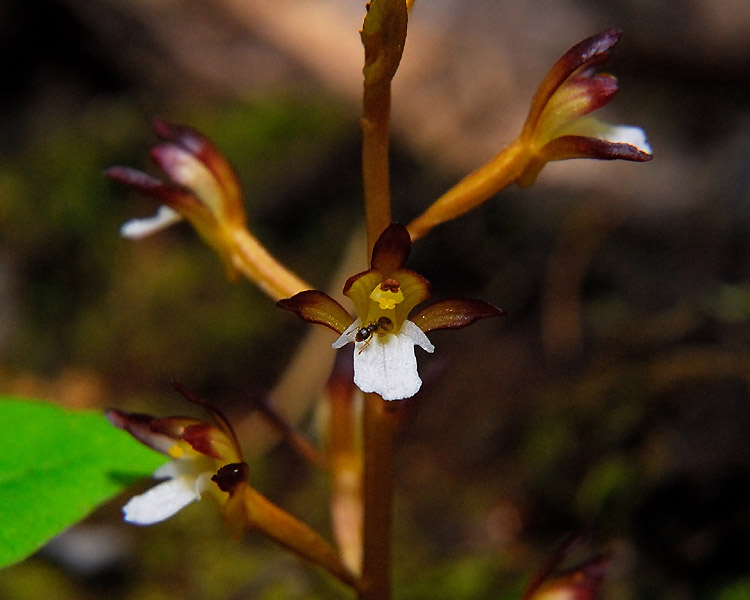

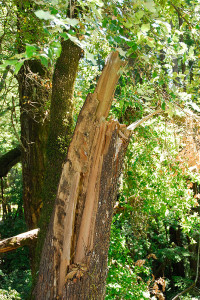
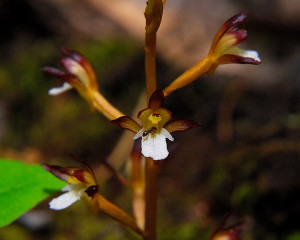

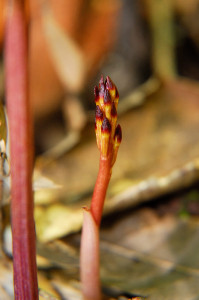
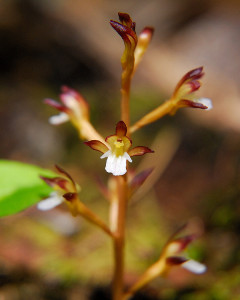

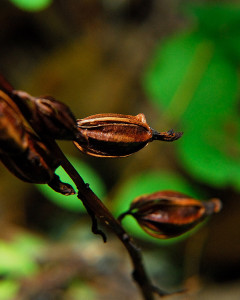
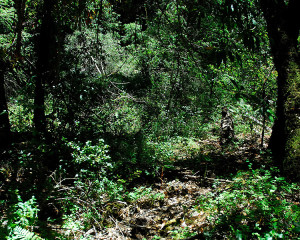
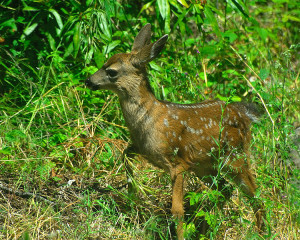







Clare, that fawn is too cute — even if he will grow up to become a menace to fruit-lovers everywhere. 😉
I never imagined an orchid so tiny, really. Your photos are gorgeous, and I love how you make it possible for me to truly see this wildflower, in such a way that if I were to ever stumble across it in the wild, myself, I might actually recognize it.
delight in receiving your post by email. absolutely love reading such informative blogs posts most especially when you make reference to native peoples use for such plants, thanks for sharing….
Wow. A parasitic miniature wild orchid. Pretty cool. A friend and I were just talking about how interesting orchids are in their form while looking at a stream orchid he has blooming. They are a very interesting family of flowers.
wow! you capture such beautiful details. The fawn is so cute, but they grow – Glad your fence is holding up
How interesting! I’m sure I would have missed it, though I actually do have quite an eye for mushrooms ;-> But that orchid, so delicate. What a fun post!
What a beautiful little orchid Clare. The photos when enlarged really show it in all its detail. I’m fascinated by terrestial orchids and their life cycle and what a bonus to have it flowering for such a long period of time.
I hope little “bambi” keeps well away from your fence…….. hopefully his inquisitiveness lapses soon.
You do go on some pretty walks! Also, you are good at identifying plants.
The fawn is very cute and I’m glad your fence is working and hope it continues to keep them away from your orchard. Pretty photos!
Love your blog. I thought I would drop a tip since you are having so many deer problems. I have had a major problem with deer in the past. I planted tulips about 4 yrs ago, and never got to see them bloom.You know why. They ate my hosta’s, tulips, daylilly’s at the brink of blooming and more. Last fall I hung little pouches of hose filled with about a cup or so of milorganite at eye level around the perimeter of my back yard. From that time one NOTHING was bothered. Including my new potager. I had tulips. In the front yard (my control) my shurbs were eaten, a new willow was rubbed in two, and deer droppings on my front walk just feet from my door. I then sprinkled more around the perimeter this spring to be on the safe side. I have tomatoes, green beans, peas, strawberries etc, plus my flowers remaining untouched. Its cheap to try out for yourself. Plus a great fertilizer.
You have the most amazing wildflowers growing on your property! Intersting information on how the natives utilized that orchid. That fawn is adorable! Almost worth giving up a few prized plants, huh?
I am jealous I admit it because you have this lovely wooded wildlife area and you find all sorts of lovely things as you go about your daily tour. Your photos are amazing btw.
Clare, I just love your natural history posts. You have such a lovely property. And your photos are GREAT. My favs on this post are the mushroom and fawn. Uh, oh, my chickens are cackling too much. I’d better go see what they want. Probably food.
Your blooms are so beautiful and unique! I love them!! Glad to hear the deer fence is holding up, too, especially with that cutie you have romping around!!
What a spunky little thing! I love all these plants you introduce me to- a parasitic orchid without leaves ain’t gonna be had at the nursery!
It’s always and joy and new learning experience visiting … I love your site, Clare!
I have a baby bunny, that like the fawn in your photograph, is too cute to dislike, but is not exactly a welcome visitor to my garden either.
That orchid is new to me. When I lived in Pacific Grove we had an “alien” orchid species growing in the backyard…I can’t remember the name just now. Here’s hoping that the deer will continue to keep away.
Hello from Stowe, VT. I came across your site while looking for information on the wild orchid Corallohiza Maculata. I saw one in our woods just today, and tho I didn’t know what it was, I was sure it was an orchid!
Great pics and description. The one I saw had a double stem and the blossoms had spots. Gotta go back and take pics! Thanks for sharing and I look forward to exploring your website/blog.